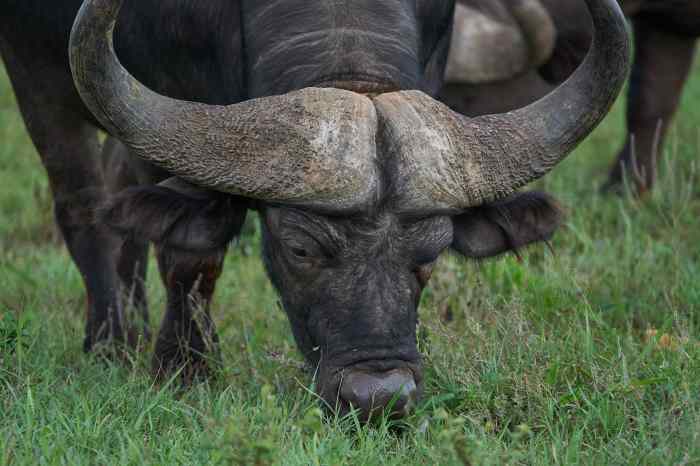African Buffalo, known for their imposing presence in the wild, roam the savannas of Africa with a captivating allure and intriguing behaviors that set them apart from other species. Delve into the world of these majestic creatures as we explore their physical characteristics, habitat, social structure, and more.
General Information: African Buffalo

African Buffaloes, also known as Cape Buffaloes, are large bovines with distinctive curved horns. They have a robust build, with males weighing around 1,000 kg and standing up to 1.7 meters tall at the shoulder. Females are slightly smaller and lighter than males. Their coat is dark brown to black in color, often turning lighter with age, and they have sparse hair on their ears and tails.
Physical Characteristics
African Buffaloes have a unique appearance with their large, curved horns that can span up to 1.5 meters in width. These horns are used for defense against predators and for dominance displays within the herd. Their hooves are broad and adapted for trampling through dense vegetation in their habitat.
Habitat and Geographical Range
African Buffaloes are found in a variety of habitats, including savannas, grasslands, and forests across sub-Saharan Africa. They are most commonly seen in countries like Kenya, Tanzania, South Africa, and Botswana. These bovines prefer areas with access to water sources and grazing grounds.
Behavior and Social Structure
African Buffaloes are known for their strong social bonds within herds, which can consist of up to several hundred individuals. They exhibit a hierarchical structure with dominant males leading the group. These animals are primarily active during the early morning and late afternoon, resting in shady areas during the hottest parts of the day. When threatened, they can be aggressive and will defend themselves as a group against predators.
Diet and Feeding Habits

African Buffaloes are herbivores with a diverse diet that mainly consists of grasses, herbs, shrubs, and occasionally fruits. They are known to graze on a wide variety of vegetation to meet their nutritional needs.
Diet Preferences
African Buffaloes primarily feed on grass, which makes up the majority of their diet. They are selective grazers, often choosing tender, young grass shoots over tougher, older plants. In times of scarcity, they may also consume leaves, shrubs, and even aquatic plants to supplement their diet.
Obtaining Food in the Wild
African Buffaloes are highly efficient grazers and can cover large distances in search of food. They typically graze in the early morning and late afternoon, resting during the hottest parts of the day. Their herding behavior helps them protect each other while feeding and allows for more efficient foraging.
Unique Feeding Behaviors and Adaptations, African Buffalo
One unique feeding behavior of African Buffaloes is their ability to consume a wide range of vegetation to survive in different habitats. They have adapted to feed on tough, fibrous grasses by having specialized molars that continuously grow throughout their lives. This enables them to effectively grind down the tough plant material they consume.
Reproduction and Life Cycle

African Buffaloes, like many other species, have specific mating behaviors and reproductive processes crucial to their life cycle.
Mating Behavior and Reproduction Process
African Buffaloes typically mate during the rainy season when food is abundant, leading to an increase in reproductive activity. Males exhibit dominance through aggressive behaviors to establish mating rights, often engaging in intense battles to compete for females. Once a male successfully mates with a female, the gestation period begins.
Gestation Period and Birth of Calves
The gestation period for African Buffaloes lasts approximately 11 months. Female buffaloes give birth to a single calf, although twins can occur in rare cases. Calves are born with a reddish coat which darkens as they grow older, providing camouflage in their natural habitat. The mother typically isolates herself from the herd during birth to protect the vulnerable calf from predators.
Parental Care and Interactions within Herds
After birth, the mother provides extensive care to her calf, nursing and protecting it from potential dangers. The bond between the mother and calf is strong, and the calf relies on its mother for survival in the early stages of life. Within the herd, other females may also exhibit maternal behaviors towards calves, creating a sense of communal care and protection. As the calf grows, it gradually integrates into the herd, learning social behaviors and survival skills from the older members.
Interactions with Other Species

African Buffaloes play a crucial role in their ecosystem, interacting with various wildlife species in their habitat. These interactions are essential for maintaining the balance and biodiversity of the environment.
Predator-Prey Dynamics
African Buffaloes are often targeted by predators such as lions, hyenas, and crocodiles. These predators rely on the buffalo as a source of food, leading to intense predator-prey dynamics in the African savannah. Buffaloes exhibit strong herding behavior as a defense mechanism against predators, with individuals working together to protect the group from attacks.
Contribution to Biodiversity
African Buffaloes play a crucial role in shaping their habitat by grazing on grasses and creating pathways that benefit other herbivores. Their presence also supports the food chain by providing a food source for a variety of predators. Additionally, buffaloes contribute to nutrient cycling through their grazing habits, which helps maintain the health of the ecosystem. Overall, African Buffaloes are integral to the biodiversity of their habitat.
In conclusion, African Buffaloes stand as essential players in the intricate web of life on the African savanna, showcasing unique behaviors and interactions that contribute to the rich biodiversity of their habitat. As we bid farewell to this exploration, the legacy of the African Buffalo continues to fascinate and inspire awe in all who encounter these magnificent creatures.






